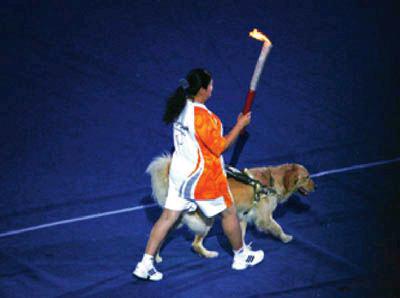Canine Companions
2014-02-12ByYuanYuan
By+Yuan+Yuan
Wu Lei, a visually impaired piano tuner from southwest Chinas Guizhou Province, had been on the waiting list of the China Guide Dog Training Center for a year.
After applying for a guide dog in December 2012, Wu finally got a call from the training center at the end of last year, asking him to participate in an adaption period with a dog. If he can get through the month with Mixiu, his potential guide dog, Wu will be the first person in Guizhou to have ever received one.
“I have been dreaming of having a guide dog for a long time,” Wu said. “I can enjoy more freedom. Im tired of having to bother my family to come with me every time I go out.”
Compared to the other 324,000 people with visual disabilities in Guizhou that have never had access to guide dogs, Wu is lucky enough to be a potential owner .
This situation is not uncommon else- where in the country. Statistics from the China Disabled Persons Federation (CDPF) show that there are 16 million people in China with visual disabilities, but there are less than 70 guide dogs for the whole country.
“According to international standards, there should be guide dogs for at least 1 percent of visually impaired people. That means we need 160,000 guide dogs, but we are long way from meeting this target,”said You Qiufang, who works with the China Guide Dog Training Center, which is based in Chinas northeastern city of Dalian, Liaoning Province.
Lonely efforts
The China Guide Dog Training Center, which was established in May 2006, is the first such facility in China.
Wang Jingyu, 49, the centers founder, spent nine years in Japan studying ethology, the scientific study of animal behavior, and obtained a Ph.D from Hiroshima University in 2001, before he returned to China and taught at Dalian Medical University.
Known as “the father of Chinese guide dog training,” Wangs idea to train guide dogs started in 2004 while he was watching the Paralympics in Athens. He saw that some of the visually impaired athletes from other countries had guide dogs. Wang decided to make an effort to rectify this for his country.
In October 2004, after a lot of research, Wang bought three Labrador retriever puppies. “Labradors and golden retrievers are considered to be the best breeds for guide dogs due to their mild temperament,” Wang said. “Guide dogs cannot be too slow or too smart. They must be patient, stable, brave and determined so that they can remain calm during emergencies.”endprint
Wang taught and trained the puppies slowly and tenaciously. When they were only a year old, he sent them to the animal research center at Dalian Medical University for further training.
In May 2006, the CDPF granted authorization to the Dalian Disabled PersonsFederation and Dalian Medical University for establishing Chinas first guide dog training base.
Training a guide dog normally takes between 18 and 24 months at the China Guide Dog Training Center and only 20 to 30 percent of puppies trained will ultimately qualify as guide dogs. Those that are selected will be sent to a volunteer family for socialization, bonding and basic obedience training.
After another year, the dogs will return to the center for more intensive skills training. Eventually, they are introduced to their human companion and work together with them at the center for a month-long adaption period. If the two of them can get through this first month successfully, the dog will go home together with their new owner and serve him or her for six to eight years.
At the 2008 Beijing Paralympics, a small number of Chinese athletes were accompanied by guide dogs that had been trained by Wang and his colleagues. Ping Yali, a torch bearer that year and the first Chinese Paralympic gold medalist, was accompanied by a dog called Lucky at the opening ceremony.
“People praised the guide dogsoutstanding performance, which was encouraging for me,” Wang said.
So far, the Dalian center has successfully trained and found suitable owners for 60 of their dogs and it is still the only guide dog training center in China that has been authorized by the CDPF.
In May 2009, a guide dog training center was set up in Dongying, east Chinas Shandong Province, and in September that same year, another such center was established in Zhengzhou, capital city of central Chinas Henan Province. However, neither of these centers have CDPFs authorization.
In April 2011, the Zhengzhou Guide Dog Training Center sent Ami, their first dog, to its owner. The first guide dog from the Dongying center is expected to begin working with its owner in early 2014.
Henan Province announced on December 16, 2013 that it would invest around 30 million yuan ($4.96 million) to establish the largest guide dog training center in China. The new center is expected to begin operations at the end of 2014.
Not easy insistence
“The cost for training a guide dog is about 150,000 yuan ($24,800) right now,” Wang said.“But visually impaired people can take them home for almost nothing at all.”endprint

Funding is something of a concern for Wang and his colleagues. Wang uses his own money to keep the China Guide Dog Training Center operational, and has even gone as far as selling his apartment.
In 2011, the Dalian Municipal Government allocated 960,000 yuan($158,600) for the training center and pledged to reimburse it 60,000 yuan ($9,910) for each dog trained and adopted.
“But this is far from enough, and the center still has a deficit of more than 400,000 yuan ($66,100),” Wang said. “ Many trainers quit over the past few years, because their wages just werent enough to make ends meet. The remaining trainers persevere because of their pure passion.”
Wang Xin has been working at the center as a trainer for three years. She, like Wang Jingyu, studied in Japan for nine years, though while there she obtained a masters degree in phycology, the study of algae. Before joining the center, she worked at a Japanese company and earned more than 10,000 yuan ($1,650) a month. But after she saw how helpful having a guide dog was for her mother, she decided to become a guide dog trainer.
“Nobody understood my decision, including my mother,” Wang Xin said. “But I love my job.”
Wang Xins first year at the center was a lot harder than she thought it was going to be. “It was frustrating when the dogs didnt follow my instructions, and the wages were just enough for basic living costs,” she said.“Some college graduates quit after a week or a month. But if you make it through the first year, you will feel better.”
Another concern facing guide dog training facilities in China is the professional and public support available to them. According to Wang Jingyu, Chinese universities and colleges have no courses on guide dog training. Although some graduates have majored in zoology, they have to learn how to train guide dogs by themselves as what they studied isnt relevant.
“China doesnt have a lot of affection for large dogs and many people are scared of them. China also lacks appropriate facilities for large dogs,” Wang Jingyu said.
A national law that took effect in 2008 recognizes the right of visually impaired people to use guide dogs and stipulates that such dogs are permitted on public transport and in public venues as long as they observe the rules.
Additonally, the Barrier-Free Environment Construction Regulations came into force on August 1, 2012. Article 16 states that “visually impaired people bringing their guide dogs into public places shall follow the relevant regulations of the state. Staff working in public places shall supply unimpeded access to them.”
However, the situation has not changed much in spite of the legal clauses. Guide dogs are still often barred from getting on buses and subways, or entering stores, markets and other public venues in most Chinese cities.
“Guide dogs are still new in China,” Wang Jingyu said. “We believe that people will be more understanding toward guide dogs in the future, but it will take time.”endprint
